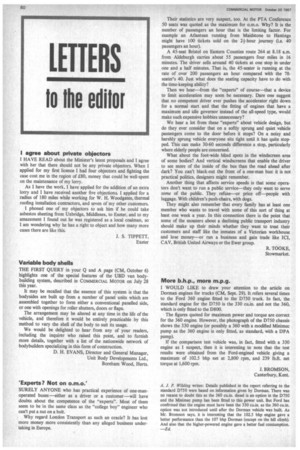'Experts? Not on o.m.o.'
Page 82

If you've noticed an error in this article please click here to report it so we can fix it.
SURELY ANYONE who has practical experience of one-manoperated buses—either as a driver or a customer—will have doubts about the competence of the "experts". Most of them seem to be in the same class as the "college boy" engineer who can't put a nut on a bolt.
Why regard London Transport as such an oracle? It has lost more money more consistently than any alleged business undertaking in Europe. Their statistics are very suspect, too. At the PTA Conference 50 seats was quoted as the maximum for o.m.o. Why? It is the number of passengers an hour that is the limiting factor. For example an Atlantean running from Maidstone to Hastings might have 100 tickets sold on the 2-1-hour journey (i.e. 40 passengers an hour).
A 45-seat Bristol on Eastern Counties route 264 at 8.18 a.m. from Aldeburgh carries about 55 passengers four miles in 16 minutes. The driver sells around 40 tickets at one stop in under one and a half minutes. That is, the 45-seater is running at the rate of over 200 passengers an hour compared with the 78seater's 40. Just what does the seating capacity have to do with the time-keeping ability?
Then we hear—from the "experts" of course—that a device to limit acceleration may soon be necessary. Dare one suggest that no competent driver ever pushes the accelerator right down for a normal start and that the fitting of engines that have a maximum and idle governor instead of the all-speed type, would make such expensive hobbies unnecessary?
We hear a lot from these "experts" about vehicle design, but do they ever consider that on a softly sprung and quiet vehicle passengers come to the door before it stops? On a noisy and harshly sprung vehicle everyone sits tight until it has quite stopped. This can make 30-60 seconds difference a stop, particularly where elderly people are concerned.
What about the foot-wide blind spots in the windscreen area of some bodies? And vertical windscreens that enable the driver to see more of the inside of the bus than the road ahead after dark? You can't black-out the front of a one-man bus: it is not practical politics, designers might remember.
Another thing that affects service speeds is that some operators don't want to run a public service—they only want to serve some of the public. They refuse—or price off—people with luggage. With children's push-chairs, with dogs.
They might also remember that every family has at least one member who wants to travel with some of this sort of thing at least one week a year. In this connection there is the point that some of the moaners about a declining public transport industry should make up their minds whether they want to treat their customers and staff like the inmates of a Victorian workhouse and lose money—or run a business and gain trade like ICI, C AV, British United Airways or the Ewer group.
R. TOOKE, Stowmarket.








































































































































